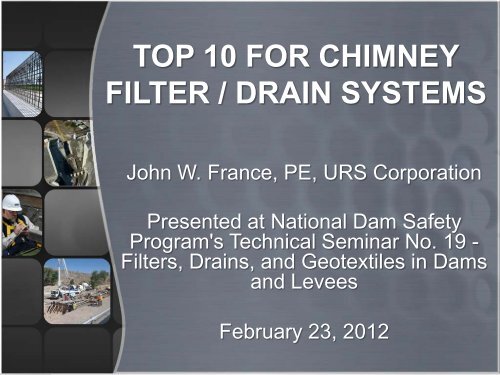Top 10 for Chimney Filter/Drain Systems (PowerPoint Slides)
Top 10 for Chimney Filter/Drain Systems (PowerPoint Slides)
Top 10 for Chimney Filter/Drain Systems (PowerPoint Slides)
- No tags were found...
Create successful ePaper yourself
Turn your PDF publications into a flip-book with our unique Google optimized e-Paper software.
TOP <strong>10</strong> FOR CHIMNEYFILTER / DRAIN SYSTEMSJohn W. France, PE, URS CorporationPresented at National Dam SafetyProgram's Technical Seminar No. 19 -<strong>Filter</strong>s, <strong>Drain</strong>s, and Geotextiles in Damsand LeveesFebruary 23, 2012
#1 – Be cautious in consideringnatural soils <strong>for</strong> filtersRare to find natural soils suitable<strong>for</strong> filters‣Not “clean” enough‣Can be gap graded‣Variable gradationsReadily available ASTM C33 fineaggregate is an excellent filter inalmost all cases
Effectiveness of ASTM C33Fine Aggregate as a <strong>Filter</strong>
#2 – Always mathematicallyregrade base soilRequired in all current filterdesign guidance: NRCS,USACE, USBRProvides retention <strong>for</strong> critical finerportion of the base soilFailure to mathematically regradecan result in substantiallyinadequate filter
<strong>Filter</strong> Gradation DesignPoint 1 is to satisfy filter requirements – prevent internal erosionPoint 2 is to satisfy permeability requirementsAll other points are to prevent gap grading and prevent segregation
Importance of Regrading theBase Soil – Example 1
Importance of Regrading theBase Soil – Example 2
#3 – Limit fines content infilters and drainsSuggest
Effect of Fines ContentAfter Barber and Sawyer, 1952
#4 – Do not overestimatepermeability of concrete sandEven with low fines content,permeability of ASTM C33 fineaggregate will be on the order of<strong>10</strong> -2 to <strong>10</strong> -3 cm/secCannot convey large seepagequantities from concentratedflowsCannot be first material placedwith flowing water
Effect of Concentrated Seepage
#5 – Consider constructabilityin selection of filter / drainzone dimensionsIn many cases calculatedseepage quantities do not requirelarge filter thicknessesConstructability will most oftencontrol filter dimensions
A Set of Suggested<strong>Chimney</strong> <strong>Filter</strong> DimensionsSimultaneous ConstructionSimultaneous ConstructionDownstreamModification
“Christmas Tree” Effectfrom Placement
Trenching Method3 ft min.
#6 – Consider methodspecifications <strong>for</strong> filter / drainmaterialsOvercompaction of filter anddrain materials is not desirable‣Increases breakdown‣Reduces permeabilityTypical filter and drain materialsare easy to compactField compaction testing can bedifficult <strong>for</strong> these materials
Typical method specifications<strong>for</strong> filter / drain materials2 to 4 coverages with vibratorycompaction equipment8-inch loose lifts; less <strong>for</strong> handoperatedequipmentFreely add water duringcompaction of clean filter
Typical CompactionCurves <strong>for</strong> Clean Sands
#8 – Include full-heightchimney filters in embankmentrepairs or enlargements Provides protection against internalerosion through defects Lowers phreatic surface‣ Preventing breakout of seepage ondownstream face‣ Increasing stability of downstream slope In risk analysis, a chimney typicallylowers probability of an unfiltered exitto 0.001 to 0.0001.
Prevention of Internal ErosionThrough DefectsWithout <strong>Chimney</strong><strong>Filter</strong>With <strong>Chimney</strong><strong>Filter</strong>
Lowering of Phreatic SurfaceWithout <strong>Chimney</strong> <strong>Filter</strong>With <strong>Chimney</strong> <strong>Filter</strong>
Internal Erosion Event Tree Reservoir Rises Erosion Initiates Erosion Continuation (lack of filtering) Progression Step 1 (roof <strong>for</strong>ms tosupport a pipe) Progression Step 2 (upstream zonefails to fill crack/pipe) Progression Step 3 (constriction orupstream zone fails to limit flows) Unsuccessful Intervention Catastrophic Breach
<strong>Top</strong> Elevation <strong>for</strong> <strong>Chimney</strong><strong>Filter</strong> Historic practice – top of estimatedphreatic surface Current practice‣ <strong>Top</strong> of maximum normal pool as aminimum‣ Often top of maximum flood pool
Discussion by R.F. Ripley,May 1982 1• P. 1194. …On the other hand, the writer hasnot found a single case of piping or internalerosion of core fines where the core wasprotected with a filter zone of cleancohesionless sand-rich material <strong>for</strong> whichcare was taken to prevent segregation duringplacement, and where necessary, the filterzone itself was adequately protected byappropriate downstream zones.1Hermusia F. Soares “Design of <strong>Filter</strong>s <strong>for</strong> Clay Cores of Dams,”ASCE Journal of Geotechnical Engineering, January, 1982
J.L. Sherard, lecture, 1984 1• P. 5. I believe there is already sufficientevidence from dam behavior, supportedby theory, to require the designer toassume that small concentrated leakscan develop through the impervioussection of most embankment dams,even those without exceptionaldifferential settlement.1“Debatable Trends in Embankment Engineering,” Presentationto the A.S.C.E. National Capital Section GeotechnicalCommittee, Seminar on Lessons Learned from GeotechnicalFailures, February 3, 1984.
Design of Small Dams, ThirdEdition, 1987• P. 190. Recently, to avoid constructiondefects such as loose lifts, poor bondbetween lifts, inadvertent pervious layers,desiccation, and dispersive soils, inclinedfilter drains in combination with ahorizontal drainage blanket have becomealmost standard. Because drainagemodifications to a homogeneous sectionprovide a greatly improved design,the fully homogeneous section shouldseldom be used.
Ronald Hirschfeld, InteragencyCommittee on Dam Safety(ICODS) article, 1995 1• Every dam should have a first line ofdefense against piping, in the <strong>for</strong>m ofa chimney drain and a blanket drainunder the downstream shell, unless thedesigner can determine that there is nounacceptable risk in eliminating one orboth.1“Design, Construction, and Inspection of EmbankmentDams to Reduce the Risk of Piping,” Seepage, Piping andRemedial Measures, March 23-24, 1995
Corps of Engineers EM11<strong>10</strong> 2 2300 (2004) 1• The primary line of defense against aconcentrated leak through the dam coreis the downstream filter (filter design iscovered in Appendix B). Sinceprevention of cracks cannot be ensured,an adequate downstream filter must beprovided (Sherard 1984).1General Design and Construction Considerations <strong>for</strong> Earthand Rock-Fill Dams
#8 – Use two-stage filter / drain ifconcentrated flows are possibleProvides capacity to handle largeflowAlso negates effects of filtercontamination
Two-Stage <strong>Chimney</strong> <strong>Filter</strong> /<strong>Drain</strong> System
Prevent Concentrated Flowsfrom Overwhelming <strong>Filter</strong>
Washakie Dam – OriginalModification
Washakie Dam – TemporaryBerm and Piezometers Readings
Washakie Dam – SecondModification
Negate Effects of <strong>Filter</strong>Contamination
#9 – Carefully select plasticpipes <strong>for</strong> toe drains andprovide <strong>for</strong> camera inspectionPer<strong>for</strong>mance of different pipetypes has variedCamera inspection providesverification – short term and longterm
Plastic Pipe MaterialsProduct Type Advantage Disadvantage Recommended?SolidStrong, weldedjoints, flexibility ofper<strong>for</strong>ation sizeand typeHighest cost, specialordered or handdrilled per<strong>for</strong>ationsHighlyHDPESingle -WallEconomicalPoor historicper<strong>for</strong>mance, weakNoCorrugatedDouble -WallEconomical,successfulapplications, largeper<strong>for</strong>ation sizesLow strength, carefulinstallation requiredModeratelyPVCSolidWellScreenDainPipeStrongSmall per<strong>for</strong>ationapertureModeratelyEconomical Weak, brittle NoCorrugatedDouble -WallEconomical Weak, Brittle NoReport DSO-09-01, Physical Properties of Plastic Pipe Used in ReclamationToe <strong>Drain</strong>s, Bureau of Reclamation, September 2009
Camera inspectionNumerous cases of damage duringconstructionCamera inspections during construction‣ After initial burial – 3 to 5 feet‣ After completion of constructionDesign considerations <strong>for</strong> inspection‣ Pipe diameter‣ Access points‣ Pipe slope
#<strong>10</strong> – Use two-stage filter /drain systems <strong>for</strong> collectorpipesSlotted pipes embedded in filtersand often become pluggedFull pipe capacity is not realized
Clogging of Slotted <strong>Drain</strong>Pipe Embedded in Sand <strong>Filter</strong>
Two examplesWashakie Dam, WY‣ Flow increased from about 50 gpm toabout 500 gpmAntero Dam, CO‣ Flow increased from about 5 gpm toabout 50 gpm
Recommended CollectorPipe Configuration
More in<strong>for</strong>mationMontana Dam Safety TechnicalNote No. 4‣ http://dnrc.mt.gov/wrd/water_op/dam_safety/technical_ref.asp‣<strong>Filter</strong>s <strong>for</strong> Embankment Dams(NDSP)‣ http://www.fema.gov/library/viewRecord.do?fromSearch=fromsearch&id=4943‣Plastic Pipe Guidelines (NDSP)‣ http://www.fema.gov/library/viewRecord.do?id=3356
Questions?
















